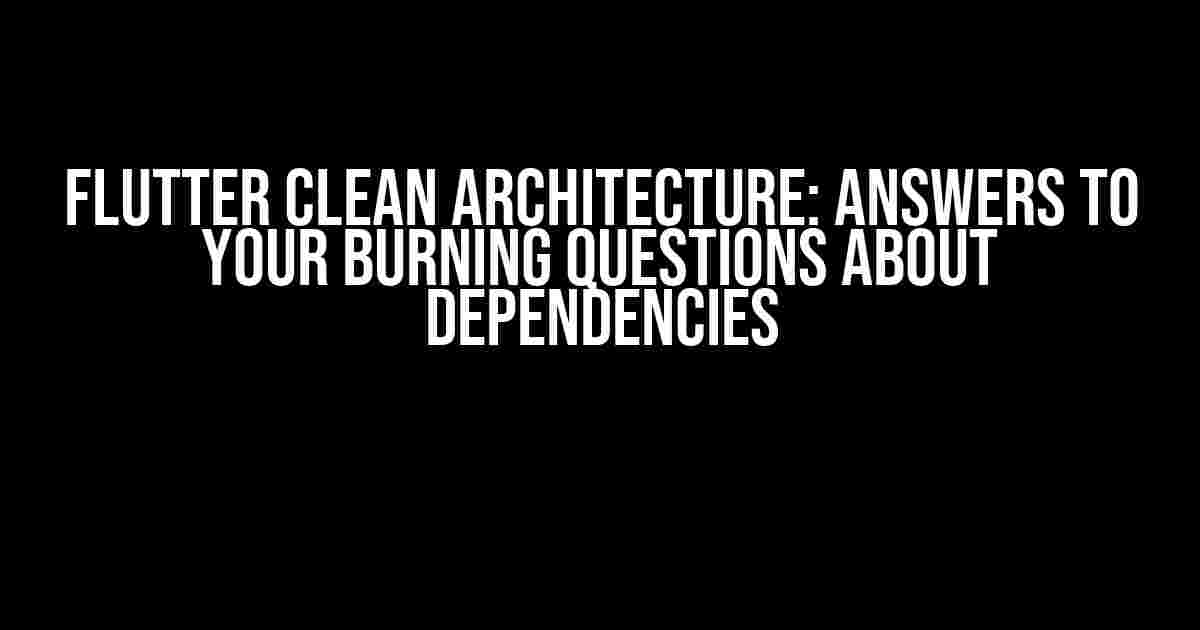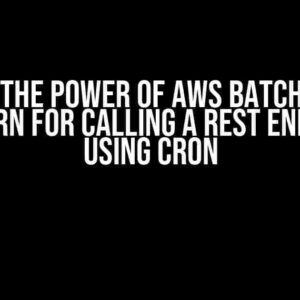Welcome to this comprehensive guide on Flutter Clean Architecture, where we’ll delve into the world of dependencies and answer the most pressing questions that have been plaguing you. Are you tired of tangled code and dependencies that seem to have a life of their own? Do you want to learn how to structure your Flutter app in a way that makes sense and is maintainable? Look no further! In this article, we’ll explore the world of Flutter Clean Architecture and provide clear, step-by-step instructions on how to manage dependencies like a pro.
What is Flutter Clean Architecture?
Before we dive into the world of dependencies, let’s take a step back and understand what Flutter Clean Architecture is all about. Clean Architecture is an architectural pattern that separates the application’s business logic from its infrastructure and presentation layers. It’s a way of structuring your code in a way that makes it easy to maintain, test, and extend.
In the context of Flutter, Clean Architecture means separating your app into three main layers:
- Entities: These are your app’s business logic, including models, interfaces, and use cases.
- Use Cases: These are the actions that your app can perform, such as logging in or fetching data.
- Interface Adapters: These are the adapters that connect your app’s use cases to the outside world, such as APIs or local storage.
Why Do Dependencies Matter in Flutter Clean Architecture?
Dependencies are the lifeblood of any Flutter app. They allow your app to interact with the outside world, fetch data, and perform actions. However, dependencies can quickly get out of hand if not managed properly. In a Clean Architecture setup, dependencies are crucial because they can make or break the separation of concerns between layers.
Imagine a scenario where your Entities layer is tightly coupled to a specific API or database. What happens if you need to switch to a different API or database? The entire app comes crashing down! That’s why it’s essential to manage dependencies in a way that keeps your layers separate and decoupled.
How to Manage Dependencies in Flutter Clean Architecture
Now that we’ve covered the why, let’s dive into the how. Here are some best practices for managing dependencies in Flutter Clean Architecture:
Use Dependency Injection
Dependency Injection (DI) is a technique that allows you to decouple your app’s components from their dependencies. Instead of hardcoding dependencies, you inject them into your components. This makes it easy to swap out dependencies without affecting the rest of the app.
// Create a dependency injection container
final container = Container();
// Register a dependency
container.registerSingleton<ApiService>(ApiService Implementation());
// Inject the dependency into a component
final myComponent = MyComponent(container resolve<ApiService>());
Use Interfaces and Abstractions
Interfaces and abstractions are the keys to decoupling your app’s layers. By defining interfaces and abstract classes, you can create a contract that specifies how dependencies should be interacted with.
// Define an interface for an API service
abstract class ApiService {
Future<String> fetchData();
}
// Implement the API service
class ApiServiceImpl implements ApiService {
@override
Future<String> fetchData() async {
// Fetch data from the API
}
}
Use Repositories
Repositories are a way of abstracting away data storage and retrieval. They act as an intermediary between your app’s business logic and the outside world.
// Define a repository interface
abstract class UserRepository {
Future<User> getUser();
}
// Implement the repository
class UserApiRepository implements UserRepository {
@override
Future<User> getUser() async {
// Fetch user data from the API
}
}
Common Pitfalls to Avoid
Managing dependencies in Flutter Clean Architecture can be tricky, and it’s easy to fall into common pitfalls. Here are some things to avoid:
- Tight Coupling: Avoid tightly coupling your app’s layers to specific dependencies. This makes it hard to switch dependencies or make changes to the app.
- God Objects: Avoid creating “god objects” that know too much about the app’s dependencies. This can lead to a mess of complexity and make it hard to maintain the app.
- Over-Engineering: Avoid over-engineering your dependency management system. Keep it simple and focused on the app’s needs.
Best Practices for Dependency Management in Flutter Clean Architecture
Here are some best practices to keep in mind when managing dependencies in Flutter Clean Architecture:
- Keep dependencies explicit: Make dependencies explicit and clear, so that anyone can understand how the app works.
- Use interfaces and abstractions: Use interfaces and abstractions to decouple dependencies and make the app more flexible.
- Separate concerns: Separate concerns by breaking down the app into smaller, independent components.
- Test dependencies: Test dependencies thoroughly to ensure they work as expected.
Conclusion
Managing dependencies in Flutter Clean Architecture is a crucial part of building a maintainable and scalable app. By following the best practices outlined in this article, you can create an app that is easy to maintain, test, and extend. Remember to keep dependencies explicit, use interfaces and abstractions, separate concerns, and test dependencies thoroughly.
| Layer | Dependency | Explanation |
|---|---|---|
| Entities | Entities should not have external dependencies. | |
| Use Cases | Interface Adapters | Use cases depend on interface adapters to interact with the outside world. |
| Interface Adapters | External Dependencies | Interface adapters depend on external dependencies, such as APIs or local storage. |
By following this guide, you’ll be well on your way to creating a Flutter app that is clean, maintainable, and scalable. Happy coding!
Frequently Asked Question
Get your Flutter clean architecture questions answered!
How do I manage dependencies in a Flutter clean architecture project?
When it comes to managing dependencies in a Flutter clean architecture project, it’s essential to keep them separate from your business logic. You can do this by using interfaces and abstractions to define the dependencies required by your use cases. This way, you can easily swap out dependencies without affecting your business logic. Additionally, consider using dependency injection to provide your use cases with the necessary dependencies.
What is the role of the data layer in a Flutter clean architecture project?
The data layer is responsible for encapsulating the data sources of your application, such as APIs, databases, or file storage. Its primary role is to provide data to your business logic layer, while abstracting away the underlying implementation details. This allows you to easily switch between different data sources or add new ones without affecting your business logic.
How do I handle errors and exceptions in a Flutter clean architecture project?
In a Flutter clean architecture project, errors and exceptions should be handled at the highest level possible, typically at the presentation layer. This allows you to provide a better user experience by displaying error messages or performing alternative actions when an error occurs. You can also use a global error handler to catch and log unexpected errors.
What is the purpose of the domain layer in a Flutter clean architecture project?
The domain layer represents the business logic of your application, encapsulating the rules and behaviors of your domain. It’s where you define your use cases, entities, and interfaces that interact with the data layer. The domain layer acts as an intermediary between the data layer and the presentation layer, providing a clear separation of concerns and making it easier to evolve your application over time.
How do I decide which dependencies to inject in a Flutter clean architecture project?
When deciding which dependencies to inject in a Flutter clean architecture project, consider the requirements of each layer. Identify the dependencies required by each use case and inject them through interfaces and abstractions. This allows you to decouple your layers and make it easier to test and maintain your application. Additionally, consider using a dependency injection framework to simplify the process of providing dependencies to your layers.


